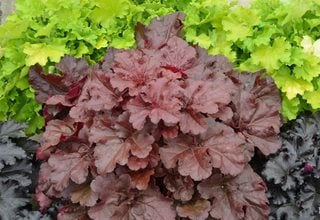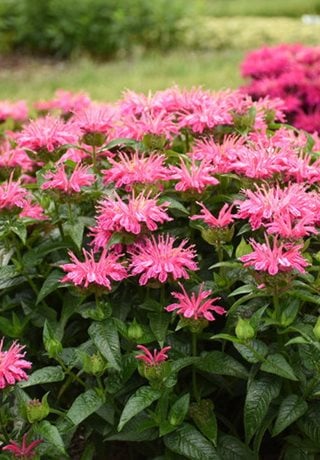A Guide to Growing Heuchera Plants (Coral Bells)
Embroider your garden with dramatic year-round color using these highly ornamental perennials
Pictured from top to bottom: Primo® ‘Pretty Pistachio’, Primo® ‘Mahogany Monster’, and Primo® ‘Black Pearl’. Photo by: Proven Winners
If you were to create a checklist for the perfect shade garden plant, coral bells (Heuchera spp.) would possess nearly all the traits you could possibly desire. Multi-season interest? Yes! Striking foliage? No question! Long-lasting flowers? Check! Minimal maintenance? Absolutely! Numerous color options? In spades! Plus, Heuchera plants are U.S natives that can tolerate a wide range of our natural habitats: woodlands, prairies, mountain peaks, and arid climates.
“Heuchera have gone through a revolutionary transformation from your grandmother's coral bells of years ago. With great diversity in leaf color and patterns, plant size, and flower performance, there are many options for the home gardener in both sun and shade," says Hans Hansen, plant breeder at Walters Gardens.
It’s no wonder coral bells have become one of the most popular perennials, with hundreds of selections and new ones available every year. Heuchera plants are also great for containers because not only do they provide year-round interest, but are drought resistant and don’t mind being confined.
On this page: Basics | Planting and Growing | Care and Maintenance | Varieties | Ideas for Using in the Garden
- CORAL BELL BASICS
- PLANTING AND GROWING CORAL BELLS
- CORAL BELLS CARE
- CORAL BELLS VARIETIES
- IDEAS FOR USING IN THE GARDEN
CORAL BELLS BASICS
Zones:
4-9
Height:
Neat mounds range in height from 6 to 18 inches tall; flower stalks grow to 2 feet or taller.
Spread:
1 to 2½ feet
Exposure:
Best in bright or dappled shade.
Bloom time:
Late spring, early summer to midsummer
Color and characteristics:
Today’s garden hybrids have colored leaves in just about every shade imaginable, some with marbled patterns, dramatic veining, silvery overlays, and ruffled edges. Tiny bell-shaped flowers rise above the foliage, swaying on tall, wispy stems.
- The tiny flowers are rich in nectar and a good food source for butterflies and hummingbirds.
- Many cultivars are exceptionally tolerant of heat, drought, and humidity.
- Provide year-round interest, with the foliage often changing color throughout the growing season and retaining its color over winter. The leaves of some varieties even give you a “bonus side” by displaying different colors on the top and bottom.
Are coral bells rabbit and deer resistant?
Heuchera plants are rarely bothered by deer and rabbits.
Heuchera vs. Heucherella:
Close cousins, and from the same plant family (Saxifragaceae), are foamflowers (Tiarella) and foamy bells (Heucherella). The latter is actually a marriage of Tiarella and Heuchera and has the same great foliage color but more pronounced bottlebrush-shaped flowers.
PLANTING AND GROWING HEUCHERA
When to plant:
Early spring.
How to plant:
Plant 1 to 2 feet apart (depending on mature size), with the base of the foliage even with or slightly above the soil level.
Growing from seed:
Although they will grow readily from seed, most varieties will not grow true to the parent plant.
Growing in containers:
Plant them in a container that has good drainage and with a potting mix that drains freely. Keep the root crown slightly higher than the soil rather than burying it deeply. If you plan to overwinter your container-grown plants, give the pots some protection from cold winter temperatures and don’t water them when dormant.
CORAL BELLS CARE AND MAINTENANCE
Light requirements:
They are most colorful when grown in partial shade (approximately 4 hours of direct sunlight daily). As a general rule, plants with pale leaf colors, like chartreuse or silver, need more protection from sun exposure than those with dark purple or maroon tones. Plants in cooler climates can often tolerate more sun if given enough moisture.
Soil requirements:
Your coral bells plant will grow best in humus-rich, well draining soil that is kept slightly moist. Avoid planting in soggy, wet soil, which can lead to crown rot. To help improve soil drainage and aeration, amend heavy garden soil with compost.
Watering:
Many are drought tolerant once they become established; however, due to their shallow roots, water your plants regularly during summer dry spells, making sure they get about an inch of water a week. Generally, little to no watering is needed during fall and winter. To prevent sun scorching of the foliage, water at the base of your plants to keep the leaves dry or water in the early morning.
Fertilizing:
Heuchera plants are not heavy feeders and will often do fine if you apply a layer of nutrient-rich compost around the plants in the spring. Container-grown plants may require a light dose of all-purpose or slow-release fertilizer.
Dividing and transplanting:
Heucheras tend to be short-lived and benefit from being divided and transplanted periodically, which will prolong their lifespan and also give you more plants for your garden. Every 3 to 4 years, dig up the existing root crown, separate the rooted offshoots, and then replant them, discarding the old woody center. The best time to transplant coral bells is in spring, or early enough in fall so they can become well-established before winter.
Pruning and deadheading:
After blooming, remove the spent flower stalks at the base. This will allow more energy for new foliage production and sometimes encourage repeat blooming. Remove any dead or sun-scorched leaves to keep the foliage looking healthy. Because food is stored in the leaves, don't prune them back in fall; wait until spring, just as new growth is starting to emerge.
Pests and diseases:
Rarely a problem, because coral bells plants have outstanding resistance to foliar diseases and pests.
Winter care:
Because they are shallow-rooted, frost heave (caused when the ground freezes and thaws) is a common problem during the winter months, especially for older plants. If the woody root crown of the plant is visible above the soil level, you can reset the plant by pulling out the root ball, placing it into a deeper hole, and then covering the area with a few inches of compost. Crown rot can also be a problem in winter if the soil doesn't drain adequately.
VARIETIES OF CORAL BELLS
Love perennials? Learn more, along with timely planting advice, garden design inspiration, tips and more in our weekly newsletter.
Featured in: Garden Design's Top 10 Garden Trends for 2022 ("Designing with Dark Foliage")
Pro Tip
"I'm a softie for Heuchera (coral bells) in the landscape and containers. The range of foliage colors is mind blowing and you'd be hard-pressed to find one that didn't work with your design. I'm especially fond of Dolce® 'Wildberry' and Dolce® 'Silver Gumdrop'. The flowers, though small, float on long stems above mounded foliage and are beloved by hummingbirds. Deer and rabbit resistant, Heuchera truly is a low maintenance perennial that works in sun or shade." — Heather, of HereSheGrows
DESIGN IDEAS
- Integrate coral bells into woodland and rock gardens and semi-shaded borders. Their shade tolerance makes them ideal as understory plants for shrubs.
- Plant in large groupings to create an attractive evergreen groundcover and to showcase the foliage color on a broader scale. Mass plantings also increase the visibility of the floral displays.
- Create textural interest by mixing them with contrasting lacy-leaved, shade-loving plants, such as ferns and astilbes.
- Use as a colorful addition to container combinations, or even as an unusual houseplant. In fall container arrangements, purple-leaved varieties are a great substitute for ornamental cabbage and kale.
- Because some varieties are more sun tolerant than others, start your plants in containers you can move around the garden until you find the sun-shade combination that gives you the best foliage color and performance.
Updated 9/23/21
RELATED:
21 Great Shade Plants
Shade Garden Ideas
20 Common Plants Safe for Cats & Dogs
Container Gardens















